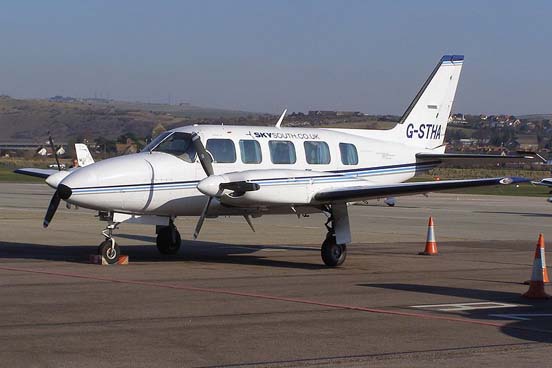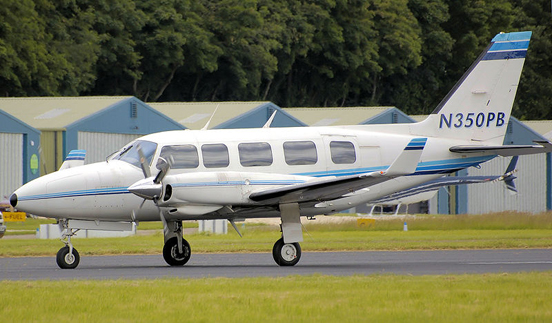 |
|
By
Wikipedia,
the free encyclopedia,
http://en.wikipedia.org/wiki/Piper_PA-31_Navajo
| Piper PA-31 Navajo |
|
|
| Piper PA-31 Navajo |
| Role |
Piston |
| Manufacturer |
Piper Aircraft |
| Designed by |
Project Engineer, Paul E. Everly |
| First flight |
30 September 1964 |
| Primary user |
Corporate |
| Number built |
2044 |
The PA-31 Navajo is a family of cabin-class, twin-engine aircraft designed and built by Piper Aircraft for the general aviation market, using Lycoming engines. It was also licence-built by Embraer as the EMB 820.
In the mid-1960s company founder William T. Piper started development of the PA-31. Targeted at small-scale cargo and feeder liner operations and the corporate market, the aircraft was a success. It continues to prove a popular choice, but due to greatly decreased demand across the general aviation sector in the 1980s, production of the PA-31 ceased.
Variants
 | |
Piper PA-31 Navajo |
 | |
1980 Navajo Chieftain |
 | |
1982 Piper PA-31 Navajo Chieftain |
The PA-31 series was produced in the following versions.
- PA-31-310 Navajo, sometimes referred to as a "straight Navajo". Also called the "Mini - Liner"
- PA-31-325 Navajo, referred to as the "CR" or Counter Rotating.
- PA-31-350 Navajo Chieftain (originally called the "Navajo II") featured a stretched cabin and more powerful engines (Lycoming TIO-540-J2BD)
- T-1020 was a Chieftain modified to be marketed to the commuter airline market.
- PA-31P-425 Pressurized Navajo (commonly referred to as "P-Navajo") was equipped with a pressurized cabin and Lycoming TIGO-541-E1A engines.
- Piper Mojave was an upgraded, reengineered version of the PA-31P
- PA-31T Cheyenne, pressurized, turboprop
- T-1040, PA-31T3, was an airline version of the PA-31T Cheyenne.
Specifications (PA-31-310 Navajo)
General characteristics
- Crew: 1, possibly 2 depending on regulations operated under
- Capacity: 6 passengers
- Length: 32 ft 7.5 in (9.95 m)
- Wingspan: 40 ft 8 in (12.40 m)
- Height: 13 ft 0 in (3.96 m)
- Wing area: 229 sq. ft (21.. m²)
- Empty weight: 3759 lb (1709 kg)
- Useful load: 2741 lb (1246 kg)
- Max takeoff weight: 6,500 lb (2,900 kg)
- Maximum ramp weight: 6,880 lb (3,130 kg) with BLRI VG System
- Maximum (STC) takeoff weight: 6,840 lb (3,110 kg) with BLIRI VG System
- Powerplant: 2× Lycoming TIO-540-A2B or -A2C, 310 hp (230 kW) each
- Propellers: constant speed, controllable pitch, fully feathering, Hartzell propeller
Performance
- Never exceed speed: 236 knots (272 mph, 437 km/h)
- Maximum speed: 188 knots (216 mph, 348 km/h)
- Maneuvering speed: 164 knots (188 mph, 304 km/h)
- Stall speed: 70 knots (80 mph, 130 km/h)
- Minimum controllable speed: 76 knots (85 mph, 137 km/h)
- Range: 1,025 nm (1,180 mi, 1,898 km)
- Service ceiling: 24,000 ft (7,300 m)
Specifications (PA-31-350 Chieftain)
General characteristics
- Crew: 1, possibly 2 depending on regulations operated under
- Capacity: 8 passengers
- Length: 40 ft 8 in (12.40 m)
- Wingspan: 40 ft 8 in (12.40 m)
- Height: 13 ft (3.96 m)
- Wing area: 229 ft² (21.28 m²)
- Empty weight: 4,003 lb (1,817 kg)
- Useful load: 2,533 lb (1,150 kg)
- Max takeoff weight: 7,000 lb (3,175 kg)
- Maximum Ramp Weight: 7,045 lb (3,195kg)
- Powerplant: 2× Lycoming TIO-540-J2BD, 350 hp (260 kW) each
- Propellers: with a constant speed, controllable pitch, fully feathering, Hartzell propeller
Performance
- Never exceed speed: 236 knots (272 mph, 437 km/h) indicated
- Maximum speed: 188 knots (216 mph, 348 km/h) indicated
- Cruise speed: 178 knots (205 mph, 330 km/h) true
- Stall speed: 77 knots (89 mph, 143 km/h) indicated
- Range: 1,025 nm (1,180 mi, 1,900 km)
- Service ceiling: 24,000 ft (7,300 m)
Accidents
See also
Related development
Comparable aircraft
Text from Wikipedia is available under the Creative Commons Attribution/Share-Alike License; additional terms may apply.
Published in July 2009.
Click here to read more articles related to aviation and space!
|
 |



